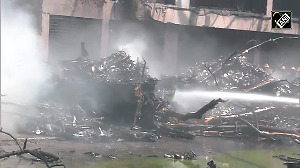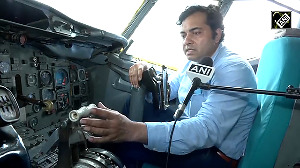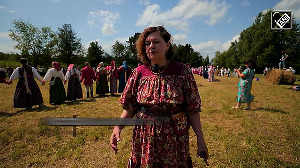A tiny village in the Himalayas leaves Time Traveller spell-bound.
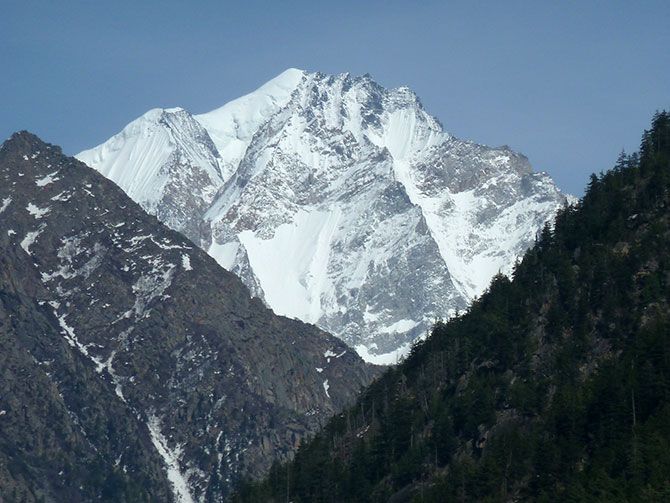
For many months, the following words of Zen Master Eihei Dogen had been reverberating intermittently in my ears:
'From time immemorial, the mountains have been the dwelling place of all the great sages. Wise ones and sages have all made the mountains their own chambers, their own body and mind, and through these wise ones and sages, the mountains have been actualised.'
'However, many great sages and wise ones we suppose have assembled in the mountains, ever since they entered the mountains; no one has actually met a single one of them. There is only the actualisation of the life of the mountains, not a single trace of their having entered remains.'/p>
'The countenance of the mountains is completely different when we are in the world gazing off at the mountains, than when we are in the mountains meeting the mountains. Our consideration and understanding of the flowing and non-flowing of the mountains should not be the same as the dragon's understanding.'
'Humans and devas reside in their own worlds; other beings may have doubts about this, or again they may not. Therefore without giving way to our surprise and doubt, we should study the words ‘mountains flow’ with the Buddha and ancestors. Taking one view, there is flowing; taking another, there is non-flowing. At one time, there is flowing and at another, there is non-flowing. If our study is not like this, it is not the true Dharma Wheel of the Tathagata.'
On delving deep into the nuances of the above passage, I was aroused by the enigmatic opportunity of attempting -- even if for an extremely small period -- to try and demystify the irrational, undecipherable sequence of circumstances and events that have surrounded and embedded my existence in this human realm.
Being aware that 'Turning Inwards' through meditation means 'attainment of the ambience of the primordial, where no thought, sound or light exists,' I decided to travel to the Gangotri area in the Himalayas, in an endeavour to study the self, forget the self and merge with the ten thousand things.
I arrived at Dharali village in Uttarakhand on April 7.
Dharali is like a home away from home to me. The ambiance is impregnated with the spiritual essence, glory, grace, holiness and blessings of innumerable sages who renounced worldly living and spent countless hours in meditation, prayer and penance before attainment of samadhi.
It is a wonderful place to pursue works of creativity like writing, composing music, painting, nature photography, etc.
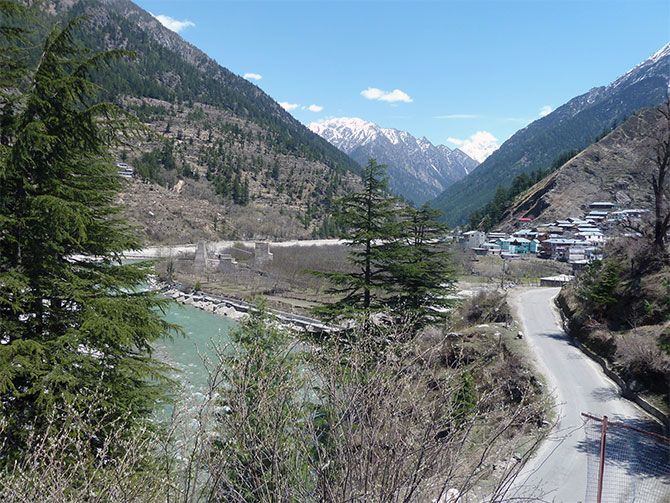
IMAGE: Dharali village set in the lap of nature.
A beautiful, tiny village, situated at an altitude of 2680 metres in the Gangotri Himalayas, Dharali is located between Uttarkashi and Gangotri (about 20 km before Gangotri and 3 km after Harshil).
The National Highway weaves through the Dharali market which is dotted with small hotels, guest houses and restaurants.
The backdrop on one side of the road leads up a mountain slope, along which 35, 40 dilapidated, archaic wooden structures house the inhabitants of this village.
Higher above, on top of the mountain, are the mythological Saat Taals or Seven Lakes. About 100 metres from the edge of the road, flows the holy Bhagirathi River (renamed downstream as the River Ganga).
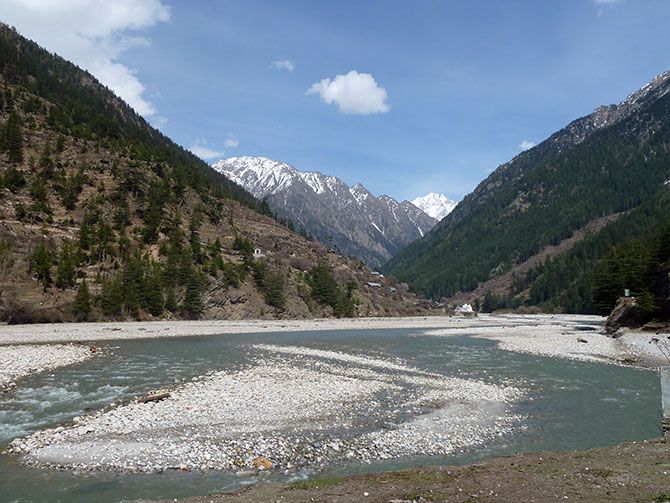
IMAGE: The Bhagirathi river looks inviting, doesn't it?
The waters of the Bhagirathi, originating from the Gaumukh glacier, are icy cold and magically pure.
Rising above the opposite bank of the river is another face of the mountain, on which stands the Mukhba village.
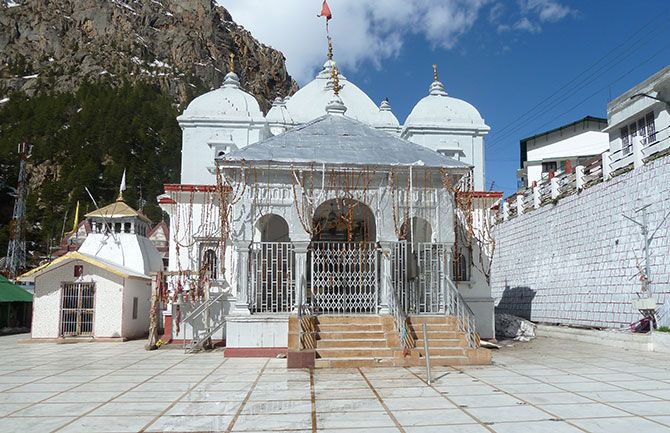
IMAGE: A vision in white: The Dharali-Gangotri Temple.
Mukhba temple is the winter abode of the idol of Goddess Ganga (which is brought down from the Gangotri temple when it is closed, during winter, between Diwali and Akshaya Tritiya).
Snow is firmly capped, in icy sheaths, atop the higher mountains that envelop Dharali.
The entire panorama reflects a surreal, supreme, tranquil spectrum of bliss, magnanimity, stillness and peace.
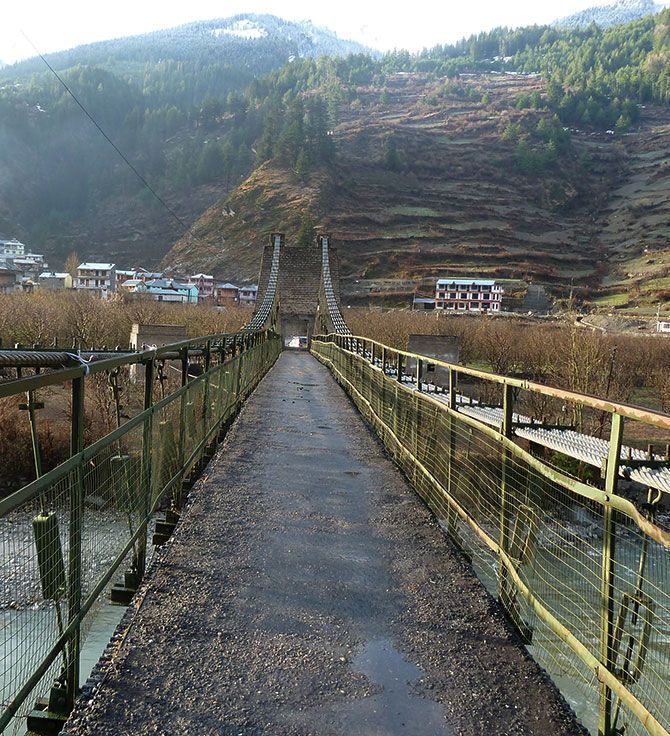
IMAGE: The ropeway bridge.
A wire-ropeway bridge across the Bhagirathi from Dharali leads to over 500 steps of winding, steep stairs that culminate at Mukhba.
Mukhba village is haven to more than 100 pandit families, who are each multi-millionaires in their own right, endowed by a sizable proportion of offerings made by devotees at the Gangotri and Mukhba temples.
Several years ago, the idol of Goddess Ganga was resident at Dharali in the off-season period and was later shifted to Mukhba.
The natives of Dharali consequently rue their fate with despondency and look upon Mukhba with inimical envy.
An ancient Shiva temple at Dharali is an awesome depiction of the illustrious cultural and architectural heritage of India. Situated beside the Bhagirathi, the temple's courtyard is an idyllic location for meditation, prayer, soul-searching and spiritual contemplation.
Dharali is buried in snow from November to March and the temperature plummets to -15 C. The river freezes and most Dharali families migrate into small rented tenements at Uttarkashi.
School-going children and their mothers/siblings are, however, permanently based at Uttarkashi. They visit Dharali only during summer vacations and Dussera holidays. Only the abject poor remain at Dharali, during winter, to brave the biting cold.
Dharali comes alive in April, when hotels, guest houses and restaurants begin to open. Indian/foreign tourists visit Dharali for sightseeing and to experience the breathtaking, tranquil, grandeur and magnificence that the mighty Himalayas behold; far from the madding crowd.
Adventurers love to undertake the 3 day trek from Gangotri to the Gaumukh glacier, in trying, enervating and relentless pursuit of a spectacle of momentary ecstasy.
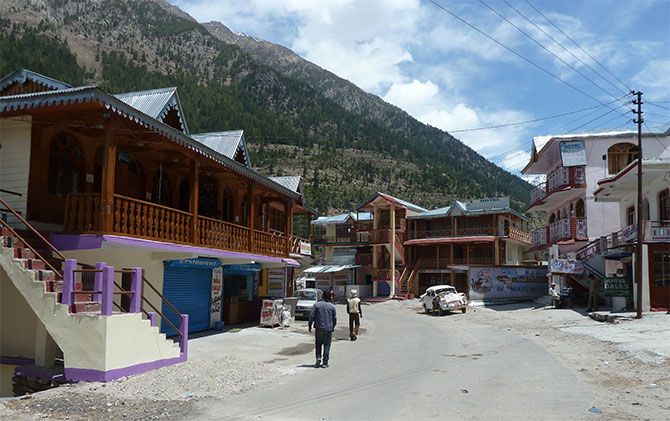
IMAGE: The Dharali marketplace.
May and June are the busiest months when an unending spate of tourists on the Chardham Yatra to the four temples (Gangotri, Yamunotri, Badrinath and Kedarnath) throng hotels, restaurants, shops and the entire Dharali marketplace. This is the critical time for Dharali folk to earn their annual living. The day begins at 3 am and often ends only after 10 pm.
I spent 20 days at Dharali from April 7 to 27, most of which was in absolute solitude.
The Shiva Dales Guest House, a small building with 8 rooms, was my home. Having contacted, in advance, the owner of Shiva Dales, Pratham Singh Panwar, who had become a friend and close acquaintance 3 years ago on a previous trip to Harshil, reservations for my stay were formalised.
I was the only occupant at Shiva Dales and the only constant external resident at Dharali during my entire stay.
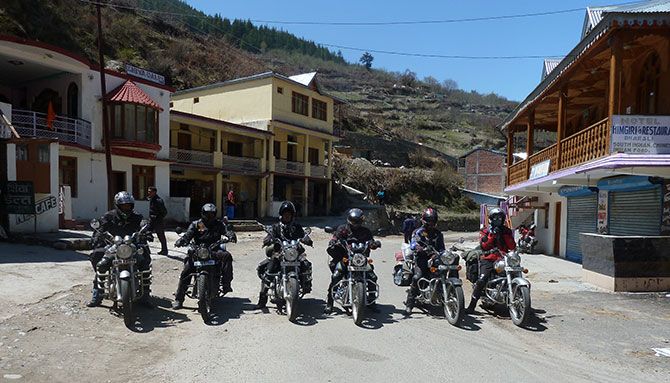
IMAGE: The India Bull Riders ready to hit the road.
A few adventurous tourists halted at Dharali for a maximum of two days each. The most enterprising of the visitors was a gang of six Royal Enfield motorcycle riders from Delhi, who called themselves 'The India Bull Riders.'
Within a couple of days of my arrival, familiarity with Dharali and its surroundings, restaurants, local folk, etc dawned upon me.
A young boy -- Bikash or Chotu -- served as my Man Friday all through my stay. He carried my backpack, cleaned the hotel room, washed my clothes, took pictures, ran all errands and also acted as my local guide.
The weather at Dharali and across the entire Gangotri area is quite unpredictable during April. The sun would be up by 5.30 am, beginning to suffuse mild warmth into the otherwise cold aura.
On some days, sun rays would prolong their glisten and render a smile and cheer on everybody's face. Otherwise, suddenly, dark clouds would sweep over from the Northern Mountains and rain would begin taking the temperature down sharply.
A long glance up the mountain above Dharali, the next morning, would be rejuvenated to spot thin toppings of snow on the coniferous trees. This snow would melt away in a couple of hours of sunlight.
Having visited the Harshil/Gangotri area earlier and roamed/trekked about the countryside extensively, I decided to stay put at Dharali and not gallivant around. Except for a one-day trip to Gangotri, my time was mostly engrossed in a regular, rigorous, schedule at Dharali.
5 am to 5.30 am: Rise out of bed. Face wash.
5.45 am: Tea at Anup Restaurant.
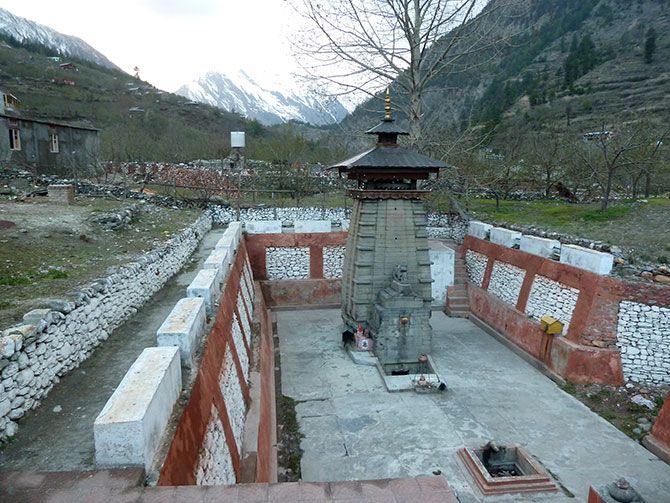
IMAGE; The Shiva temple.
5.50 am: Walk to the Shiva temple at the end of Dharali market for brief prayer and momentary obeisance.
6 am: Walk along pathway in precincts of the Shiva remple courtyard to the bank of the Bhagirathi. Cautiously amble down a potpourri of rocks and loose sand to reach a favourite spot -- a flat rock that is constantly brushed on the side by the flowing river waters.
6.15 am to 9.15 am: With the sky above and the river flowing alongside, sit cross-legged on a flat rock and half-gaze in blurred sight at the snow covered Himalayan peaks, and meditate.
9.30 am to 9.45 am: Heavy brunch of rotis, dal, sabzi and salad at Anup Restaurant.
10 am to 11.45 am: Heat water (with electric immersion rod carted by me), bathe, freshen up and change.
12 noon to 3 pm: Back at riverside for reading, reflection and contemplation. Sit in idle consternation, staring blankly into the river or at the mountains and ruminate over the learnings from the realisations and guidance of revered/enlightened spiritual masters like Jamyang Khyentse, Milrepa, John Daidoo Loori, Eihei Dogen, Gautama Buddha, Sogyal Rinpoche, etc.
3.30 pm to 4.30 pm: Have tea and then walk into the mountain forest or along the riverbed in peripatetic objective. Let the chilly freshness sink into the being, and revel in the still, glorious ambience of the river, mountains, waterfalls, forests, flora and fauna. Be glued to the immediate NOWNESS, in ecstatic enchantment
4.45 pm: Having calmed and tamed the mind, and imbibed with adrenalin infused by the sacrosanct pureness of Mother Nature, trot back to the riverside for an energised bout of meditation.
5 pm to 7 pm: Meditation.
7 pm: Arrival of Chotu who would shake me out of an ethereal stupor and proclaim a firm command to walk back to the market, given the time, darkness and cold wind.
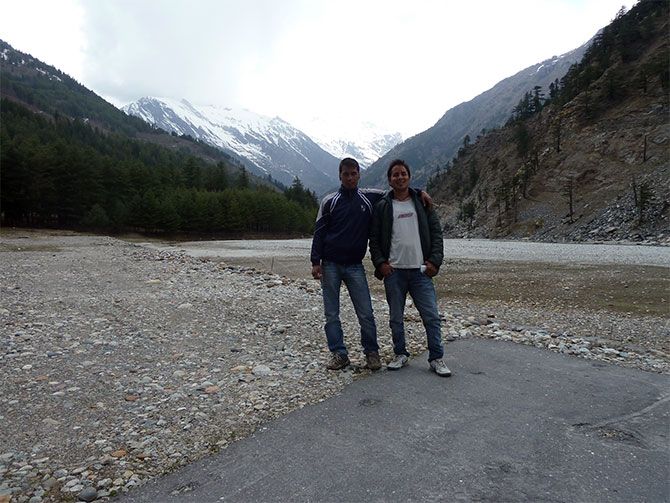
IMAGE: Youngsters in Dharali smile for the camera.
7.15 pm to 8.15 pm: Casual banter at Anup Restaurant with diverse Dharali folk who would seize the opportunity to voice their grievances, hardships, trials and tribulations.
8.30 pm to 9 pm: Light Dinner (usually Maggi Noodles) and then walk up and down the deserted Dharali market road.
9 pm onwards: Return to room, change, lie in bed and settled comfortably beneath two thick razais. Put the mind in the hara, taste/follow every inhalation/exhalation of breath, remain blank in thought and drift into the wonder worlds of Sushputi and Sapna.
I endeavoured to read, reflect, contemplate and meditate on the 'Nature of Mind', as elucidated upon in The Tibetan Book of Living and Dying by Sogyal Rinpoche.
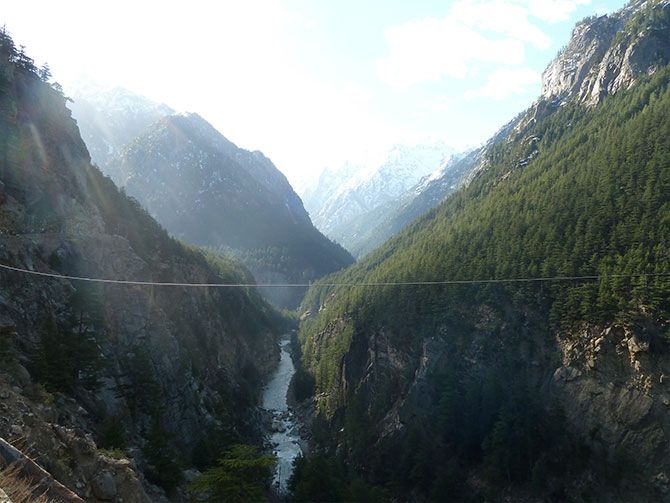
IMAGE: The Bhagirathi.
Each time I entered into the practice of meditation, I first immersed myself in the words 'AUM MANI PADME HUM,' which literally mean 'The jewel is already in the lotus,' and euphemistically connoted as 'The arrow is already in the target.'
As past thoughts died away and future thoughts had not yet arisen, in that gap of the NOW, the practice of Mindfulness began to diffuse negativity, aggression, pain, suffering and frustration.
As I began to relax, more and more, I stayed alert and aware. As all tensions were released, body and mind fell away and, in fleeting moments, I caught momentary, fleeting glimpses of something that is inherently indescribable.
On April 27, as I packed my bags and prepared to embark on the journey back to the world of samsara, a sense of inertness overcame me. All my Dharali buddies -- Pratham, Chotu, Sachinder, Jitender, Arjun, Guddu, Mukesh, Binay, Rajbir, Rakesh, Dhani, Koushik and others -- solemnly watched as I bowed in reverence to the mighty mountain and the eclectic river, in gratefulness, for the opportunity to experience 'Reality' in evanescence.
Birth, Life and Death now construed a new meaning -- NOTHING. There is no destination. The Goal is the Road.
All photographs: Time Traveller.









